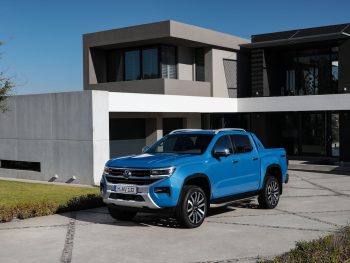George Barrow gets to grips with the latest iteration of the Volkswagen pick-up.

There comes a time in every pickup truck driver’s life when someone asks about the engine in their truck. People expect them to have large V-shaped engines but, for a while now, that’s not been the case. In fact the last pickup truck able to coo about its V6 engine was the Volkswagen Amarok, which went off sale in 2019. Fortunately for those of us with the desire for a large engine – and perhaps a shade of an inferiority complex, the Amarok is back. And so too is the V6.
Before you go running to Volkswagen applauding it (or chastising it, depending on your ecological outlook), it’s worth knowing that the new Amarok and its hefty 3.0-litre V6 are actually the work of Ford. The new Amarok is the latest instalment in the Ford and Volkswagen collaboration agreement, which has already given us the Volkswagen Caddy-based Ford Transit Connect. Ford has taken the reins for the pickup truck part of the process meaning that the Amarok is in fact based on the new Ford Ranger, using the chassis, tech, engines and know-how of the market leader to re-introduce itself into the marketplace.
It’s not just about big engines, the Amarok is available with a 2.0-litre four-cylinder turbodiesel, delivering more modest 168hp or 203hp outputs, compared with the 237hp of the 3.0-litre V6 turbodiesel. Buyers can opt for a manual six-speed transmission or a 10-speed auto from the Ford CV range, and there is, of course, a low-range gearbox and locking rear differential. But there is also now the option of selectable or permanent four-wheel drive and, while the range in the UK will be limited to double-cab models only, there are five trim options to choose from. The entry-level Amarok is followed by Life, then Style trims as well as a more well-equipped but off-road focused PanAmericana and a luxurious lifestyle Aventura variant. It’s a range that speaks to the masses and should, on paper, be able to take on the Ranger.
The Ranger connection
Aside from gauging your engine size, naysayers will say the Amarok is just a rebadged Ranger. While that might be accurate when it comes to the stuff under the metalwork, there’s a lot more to the collaboration than a trolley full of VW badges at the end of the Ford production line. Volkswagen has endeavoured to change just about everything it can realistically do with the Amarok to differentiate it from the Ranger. That means only the door handles, wing mirrors and the roof are common across the two products. On the inside, the 12-inch touchscreen is a massive giveaway that it’s a Ford as it’s the same screen you’ll find in an E-Transit, but the software is VW’s and important separations such as those help the Amarok stand on its own.
On the road
The Amarok driveline has been tuned to be more VW-like. In short, it has lighter steering – almost unbecoming of a pickup truck – but still meaty enough to give you good feedback when off-road and there’s a more pliant and smoother ride. The engines may be the same, but VW has done what it can to make the Amarok different and it has done it successfully.
The new Amarok is better in all areas than the previous model, but it’s like comparing a “sorry we missed you card” to the convenience of one of those parcel lockers – it serves the same purpose but is a different concept for a different time. The previous Amarok arrived in a wave of luxury pick-ups when it was launched in 2010 but the concept has been finessed and perfected by the Ford Ranger since.
The Ranger-based Amarok is therefore better suited than ever to the modern pickup owner and is bigger, better, and bolder. The approach angle increases slightly to 30°, while the departure angle jumps 8° to 26°. The breakover angle makes a similarly large increase from 15.6° to 21° with the ground clearance up 45mm to 237mm. The Amarok can now wade through 800mm of water too – up from 500mm.
VERDICT
It is definitely a better Amarok this time around and, while it’s lost some of the character that made the previous model feel typically Volkswagen-like, the new Amarok still has its own appeal and will undoubtedly find a loyal following once again.
As much as Volkswagen would like the Amarok to be competing with the Ranger for customers, it’s unlikely to snatch many thousands of customers away. It will instead live happily alongside the Ranger as its close relation rather than as a copycat and will trouble the Toyota Hilux, Isuzu D-Max and SsangYong Musso for good measure.
It will do so while wearing its premium Volkswagen badge with the prestige of a gutsy V6 engine and, because of that, plenty of customers will happily answer the question about the size of their engine and its platform sharing without any sniff of feeling inferior, and rightly so too.
IN BRIEF
WHAT IS IT? Double cab pick-up
HOW MUCH? £44,000 (est) Aventura trim
GROSS PAYLOAD? 1,190kg
MPG? 33mpg (est)
GROSS PAYLOAD? 800kg
DRIVE? 367hp at 3,250rpm/600Nm torque at 1,750 to 2,000rpm, 3.0-litre twin turbocharged diesel engine. 10-speed automatic transmission.

